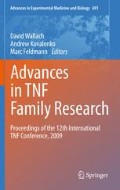Abstract
Recent evidence indicates that TNF-like death cytokines can induce apoptotic and non-apoptotic forms of cell death. We have coined the term “programmed necrosis” to describe caspase-independent cell death induced by TNF-like cytokines. Besides an obligate requirement for the protein serine/threonine kinase RIP1 and the production of reactive oxygen species (ROS), relatively little is known about the molecular mechanisms that control TNF-induced programmed necrosis. In order to further illuminate the molecular pathway that governs programmed necrosis, we performed a targeted RNA interference (RNAi) screen. Our screen identified RIP3, a RIP1 family member, as a specific mediator for programmed necrosis, but not apoptosis. Biochemical analyses show that assembly of the pro-necrotic RIP1–RIP3 complex critically regulates induction of programmed necrosis. The physiological relevance of RIP3-dependent programmed necrosis is demonstrated by the failure of RIP3-deficient mice to control vaccinia virus infections.
Access this chapter
Tax calculation will be finalised at checkout
Purchases are for personal use only
References
Galluzzi L, Kepp O, Kroemer G(2009) RIP kinases initiate programmed necrosis. J Mol Cell Biol 2009 1(1):8–10
Kono H, Rock KL (2008) How dying cells alert the immune system to danger. Nat Rev Immunol 8(4):279–289
Holler N et al (2000) Fas triggers an alternative, caspase-8-independent cell death pathway using the kinase RIP as effector molecule. Nat Immunol 1(6):489–495
Chan FK et al (2003) A role for tumor necrosis factor receptor-2 and receptor-interacting protein in programmed necrosis and antiviral responses. J Biol Chem 278(51):51613–51621
Lin Y et al (2004) Tumor necrosis factor-induced nonapoptotic cell death requires receptor-interacting protein-mediated cellular reactive oxygen species accumulation. J Biol Chem 279(11):10822–10828
Cho YS et al (2009) Phosphorylation-driven assembly of the RIP1-RIP3 complex regulates programmed necrosis and virus-induced inflammation. Cell 137(6):1112–11123
Micheau O, Tschopp J (2003) Induction of TNF receptor I-mediated apoptosis via two sequential signaling complexes. Cell 114(2):181–190
Degterev A et al (2008) Identification of RIP1 kinase as a specific cellular target of necrostatins. Nat Chem Biol 4(5):313–321
Vanlangenakker N et al (2008) Molecular mechanisms and pathophysiology of necrotic cell death. Curr Mol Med 8(3):207–220
Kim YS et al (2007) TNF-induced activation of the Nox1 NADPH oxidase and its role in the induction of necrotic cell death. Mol Cell 26(5):675–687
Yazdanpanah B et al (2009) Riboflavin kinase couples TNF receptor 1 to NADPH oxidase. Nature 460(7259):1159–1163
Zhang J et al (1998) Fas-mediated apoptosis and activation-induced T-cell proliferation are defective in mice lacking FADD/Mort1. Nature 392(6673):296–300
Chun HJ et al (2002) Pleiotropic defects in lymphocyte activation caused by caspase-8 mutations lead to human immunodeficiency. Nature 419(6905):395–399
Zhang Y et al (2005) Conditional Fas-associated death domain protein (FADD): GFP knockout mice reveal FADD is dispensable in thymic development but essential in peripheral T cell homeostasis. J Immunol 175(5):3033–3044
Bell BD et al (2008) FADD and caspase-8 control the outcome of autophagic signaling in proliferating T cells. Proc Natl Acad Sci USA 105(43):16677–16682
Ch’en IL et al (2008) Antigen-mediated T cell expansion regulated by parallel pathways of death. Proc Natl Acad Sci USA 105(45):17463–17468
Li M, Beg AA (2000) Induction of necrotic-like cell death by tumor necrosis factor alpha and caspase inhibitors: novel mechanism for killing virus-infected cells. J Virol 74(16):7470–7477
He S et al (2009) Receptor interacting protein kinase-3 determines cellular necrotic response to TNF-alpha. Cell 137(6):1100–1111
Zhang DW et al (2009) RIP3, an energy metabolism regulator that switches TNF-induced cell death from apoptosis to necrosis. Science 325(5938):332–336
Acknowledgment
This work was supported by NIH grant AI065877. F.K.C. was a recipient of investigator awards from the Smith Family Foundation and the Cancer Research Institute.
Author information
Authors and Affiliations
Corresponding author
Editor information
Editors and Affiliations
Rights and permissions
Copyright information
© 2011 Springer Science+Business Media, LLC
About this paper
Cite this paper
Cho, Y., Challa, S., Chan, F.KM. (2011). A RNA Interference Screen Identifies RIP3 as an Essential Inducer of TNF-Induced Programmed Necrosis. In: Wallach, D., Kovalenko, A., Feldmann, M. (eds) Advances in TNF Family Research. Advances in Experimental Medicine and Biology, vol 691. Springer, New York, NY. https://doi.org/10.1007/978-1-4419-6612-4_62
Download citation
DOI: https://doi.org/10.1007/978-1-4419-6612-4_62
Published:
Publisher Name: Springer, New York, NY
Print ISBN: 978-1-4419-6611-7
Online ISBN: 978-1-4419-6612-4
eBook Packages: Biomedical and Life SciencesBiomedical and Life Sciences (R0)

